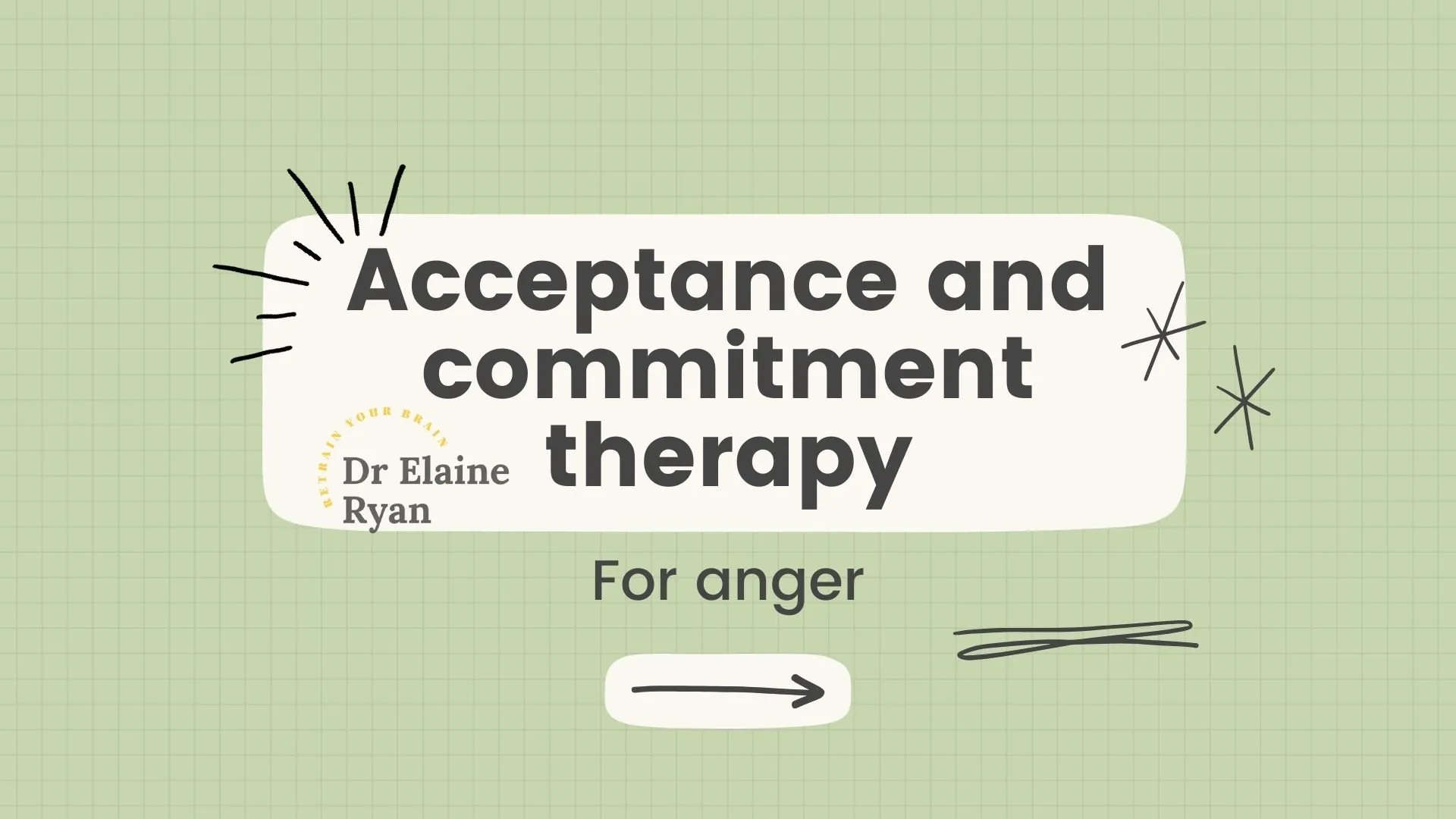Acceptance and Commitment Therapy (ACT) is a useful model for helping people with anger problems. ACT doesn’t try to get rid of anger; rather, it helps you respond to things that make you angry in a different way.
Retrain Your Brain® Anger Management

Dr Ryan’s online self-help course for anger
How does ACT work for anger?
ACT is built around six core processes, and they all promote a concept called psychological flexibility. It’s the psychological flexibility that I find most valuable when helping people manage their anger as unlike other models of therapy, you are not encouraged to move away or do something with your anger, rather ACT would get you to stay in the present moment and adapt (hence being flexible.)
You can read more ACT here on my site, or on this article on PsychologyToday. For a more indepth explanation of the emotion of anger please see here.
I’ll shall give a quick example to explain this concept now, and it will also draw more of the components of ACT. Aoife, is feeling extremely angry after a run in with someone at work, she is angry as she feels her colleague disrespected her ideas and contributions.
Psychological Inflexibility (Unhelpful Response):
- Fusion with Anger:Aoife becomes completely absorbed by her anger, replaying the argument in her mind and thinking about how wrong her colleague was.
- Experiential Avoidance: She tries to avoid feeling angry by distracting herself with unrelated tasks or venting excessively to other colleagues.
- Disconnection from Values: She might start behaving in ways that are contrary to her values, such as giving her colleague the silent treatment, gossiping about him, or doing subpar work on the project out of spite.
Psychological Flexibility (Helpful Response):
- Acceptance: Aoife acknowledges her anger without trying to suppress or avoid it. She notices the physical sensations of anger (e.g., tightness in her chest) and the thoughts running through her mind.
- Defusion: Instead of getting entangled with her angry thoughts, Aoife practices defusion techniques. She might say to herself, “I’m having the thought that Tom ( her colleague) is disrespectful,” which helps her gain some distance from her thoughts and see them as just thoughts, not absolute truths.
- Present Moment Awareness: Aoife brings her attention back to the present moment, perhaps by focusing on her breath or her immediate surroundings, which helps her ground herself and reduces the intensity of her anger.
- Values Clarification: She reflects on her core values, such as professionalism, respect, and collaboration. She asks herself how she wants to behave in this situation to stay true to those values. This is a very powerful point when you are starting to work with your anger. How I phrase it to clients is ‘ask yourself how you want to feel about yourself when this is over. What outcome do you want to achieve?’
- Committed Action: Guided by her values, Aoife chooses to address the conflict constructively. She might decide to have a calm and honest conversation with Tom about how she felt during their argument and work together to find a resolution. Alternatively, she might focus on contributing her best work to the project regardless of her personal feelings toward Tom.
- By applying psychological flexibility, Aoife can manage her anger in a way that reduces its negative impact on her and her work environment, fostering better relationships and more effective problem-solving.

In the example with Aoife I mentioned some concepts of acceptance and commitment therapy which I shall explain now.
Acceptance: This involves embracing thoughts and feelings without judgment. Acceptance is a central concept in ACT. It involves embracing our thoughts and feelings without judgment. This includes accepting our anger. When we accept our anger, we acknowledge it without trying to suppress or control it. We allow it to be present without letting it dictate our actions. This acceptance can reduce the intensity of our anger and help us manage it more effectively.
Cognitive Defusion: This technique helps individuals detach from unhelpful thoughts. Cognitive defusion is a core technique in ACT. It involves learning to see our thoughts as just thoughts, rather than facts. This can be particularly helpful when dealing with anger-provoking thoughts. By practicing cognitive defusion, we can learn to observe our thoughts without getting caught up in them. This can help us respond to anger in a more adaptive way, rather than reacting impulsively.
Being Present: This encourages mindfulness and present-moment awareness. Mindfulness is another key technique in ACT. It involves paying attention to our present moment experience, without judgment. This can be particularly helpful in managing anger. By practicing mindfulness, we can learn to observe our anger without getting caught up in it. We can notice the thoughts and feelings that come with anger, without letting them control our actions. This can help us manage our anger more effectively and live in line with our values.
Self as Context: This process helps individuals separate their identity from their thoughts and feelings. ACT emphasizes the importance of aligning our actions with our personal values. This is particularly relevant when it comes to managing anger. When we’re angry, it’s easy to react in ways that don’t align with our values. But by committing to value-based actions, we can choose responses that are more in line with who we want to be. This can help reduce the frequency and intensity of our anger episodes.
Values: This involves identifying what truly matters to an individual. Committed Action: This encourages actions aligned with personal values. Establishing committed action plans is a key part of ACT. These plans involve setting specific, measurable goals that align with our values. For example, if one of our values is patience, a committed action plan might involve practising patience in situations that typically provoke anger.
By setting and working towards these goals, we can make meaningful progress in managing our anger. Remember, these plans should be flexible and adaptable. It’s not about achieving perfection but about making consistent efforts to live in line with our values. This can help us manage our anger more effectively and live a more fulfilling life.
ACT vs. Traditional CBT
If you have attended me before for therapy with your anger, you were more than likely referred by your GP for CBT, but having the ability to integrate other models can help different aspects of anger. For example, CBT focuses on changing negative thoughts and behaviours. It aims to replace them with more positive or adaptive ones whereas ACT will not touch those thoughts, rather it will encourage you to accept your thoughts, without getting caught up in them or caught up in the emotion, as you hopefully saw in the example above with Aoife.
Similar to CBT, ACT is a very practical model, and perhaps this is why I like working with it so much as I value hands-on practical tools.
Further Resources and Support For those interested in learning more about ACT for anger management, there are many resources available. These include books, online courses, and workshops. Here are a few to get you started: “The Happiness Trap” by Dr. Russ Harris “ACT on Life Not on Anger” by Dr. Georg H. Eifert, Dr. John P. Forsyth, and Dr. Matthew McKayClear
